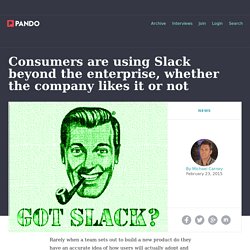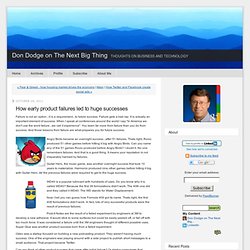

Consumers are using Slack beyond the enterprise, whether the company likes it or not. Rarely when a team sets out to build a new product do they have an accurate idea of how users will actually adopt and make use of its features.

Look no further than Twitter, which has embraced and productized the hacked-together features created by its earliest and most engaged users, including tagging (@), retweets (RT), hashtags (#), and favorites (✭). The truth is, when you build a great product that solves a real market need, users will flock to that solution and in many cases fund new and novel ways to make use of it. We are starting to see the same phenomenon with Slack, the popular team communication platform that has quickly emerged as an enterprise favorite and a darling in Silicon Valley. But it’s not just business teams that are using the platform for internal communication. Organizations and individual consumers are flocking to the platform in droves, repurposing Slack as a public or at least external communication forum. This is the kind of adoption money can’t buy. A blog is a mini-startup - Leknarf. Launching a new blog isn’t dissimilar to launching a startup.

In fact, the difficulties in launching a blog are effectively a sub-set of the key problems to solve when creating a startup. Specifically, building a new blog requires you to figure out the following questions: Who are your potential readers? How will those readers find your blog? Will those readers subscribe, share, comment, or otherwise engage with your content? If these questions sound familiar, that’s because they are fundamental to the first two steps in Steve Blank’s The Four Steps to the Epiphany, namely “Customer Discovery” and “Customer Validation”. Customer Discovery Discovery is a fairly obvious requirement for a new blog. More importantly, by accepting that building a readership just requires some honest labor, you can avoid a common pitfall. Customer Validation Validation requires a little more thought. In particular, some plausible motivations for blogging are to: Practice the hard stuff.
2012 David O. Selznick Producers Guild Award Tribute to Steven Spielberg. How early product failures led to huge successes. Failure is not an option...it is a requirement...to future success.

Failure gets a bad rap. It is actually an important element of success. When I speak at conferences around the world I say "In America we don't use the word failure...we call it experience". You learn far more from failure than you do from success. And those lessons from failure are what prepares you for future success. Angry Birds became an overnight success...after 51 failures. Guitar Hero, the music game, was another overnight success that took 10 years to materialize. WD40 is a popular lubricant with hundreds of uses. Now I bet you can guess how Formula 409 got its name. Post-It Notes are the result of a failed experiment by engineers at 3M to develop a new adhesive.
How to Increase Product Profitability After Launch. LUXr - the lean user experience residency. Program - LUXr. How To Make Your Product Stand Out Without Going Broke. Memory Inception: Three Keys To Creating A Great User Experience For Your Product. Editor’s note: This guest post is written by Dmitry Dragilev, the lead marketer at ZURB, an interaction design firm whose clients have included Facebook, eBay, Yahoo, NYSE, Britney Spears, and Zazzle.

They are also behind the Web notation products Notable and Bounce. Ever read a great book? What do you remember about it? Maybe a few dramatic moments, some wild story twists, and most definitely the ending. Your product is just like a book. There are millions of books, courses and talks out there about building great products online. It turns out there are three different kinds of moments in your story customers remember: transitions, Wow moments, and endings. How to plant a memory There are three particular kinds of experiences capable of turning an ordinary moment into a memory that will stick in your customer’s head. 1. These are similar to those surprising plot twists in a story. . ● Ever Skype with your grandparents in a remote village in the middle of nowhere? 2. 3.